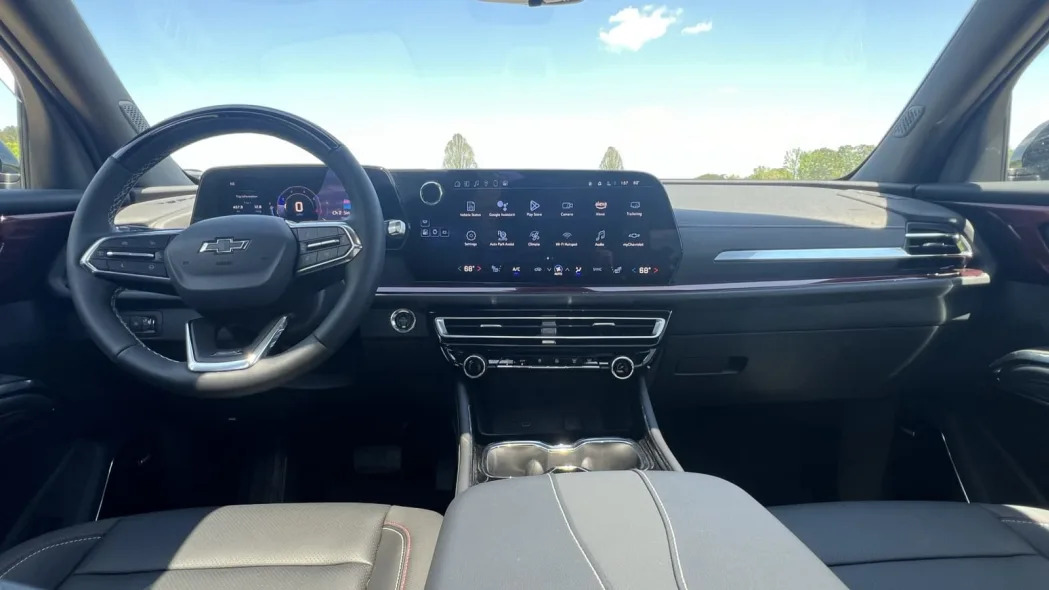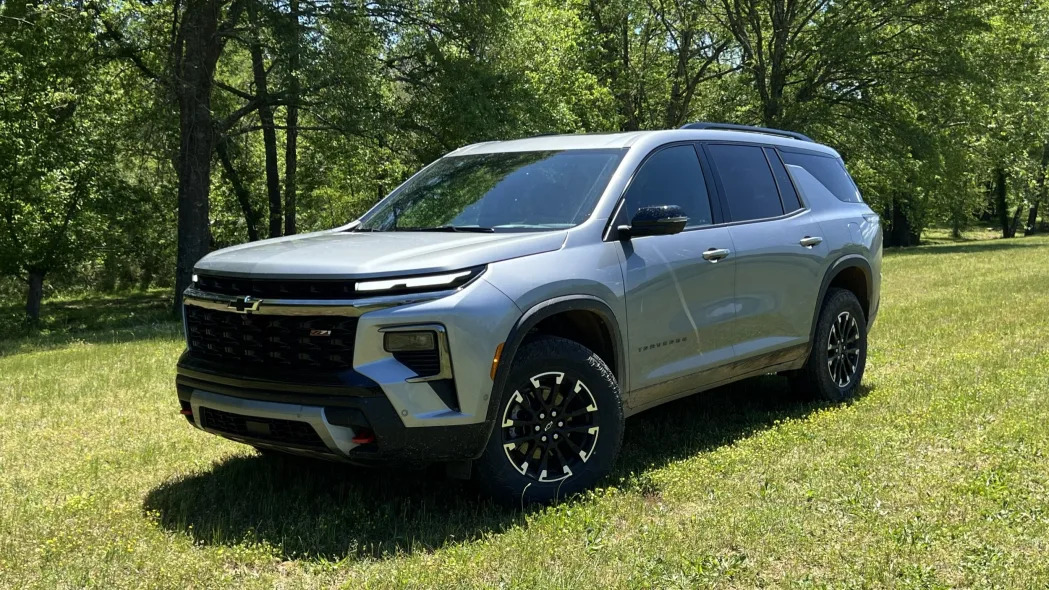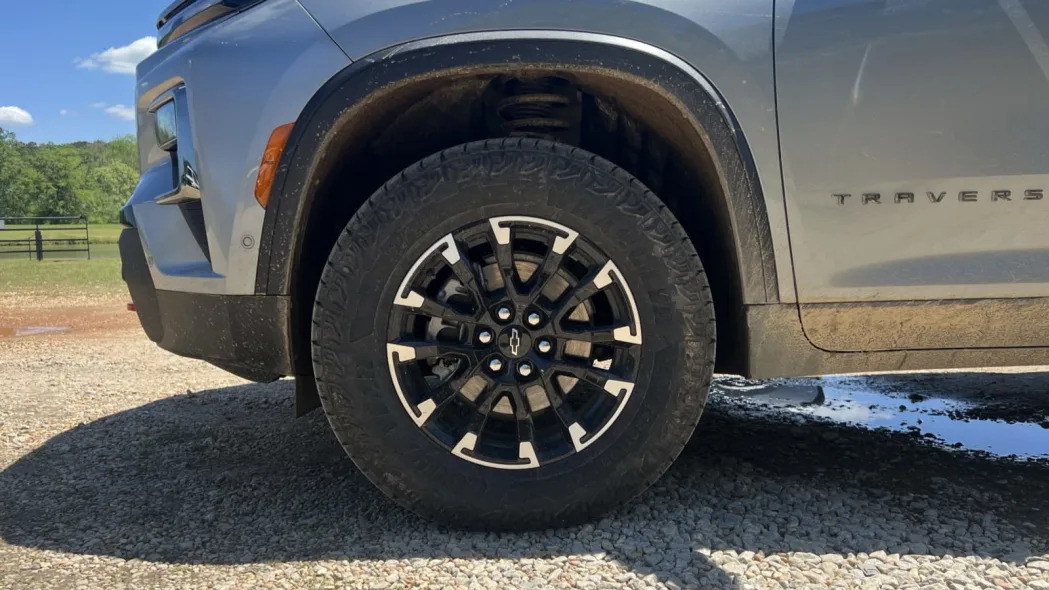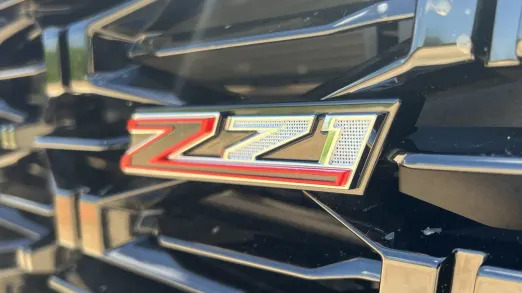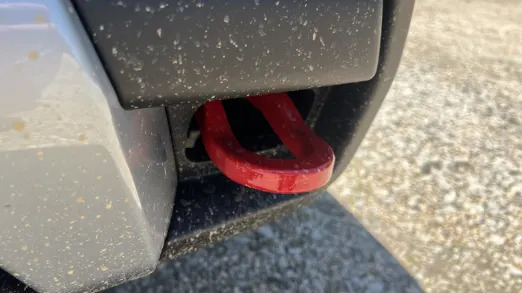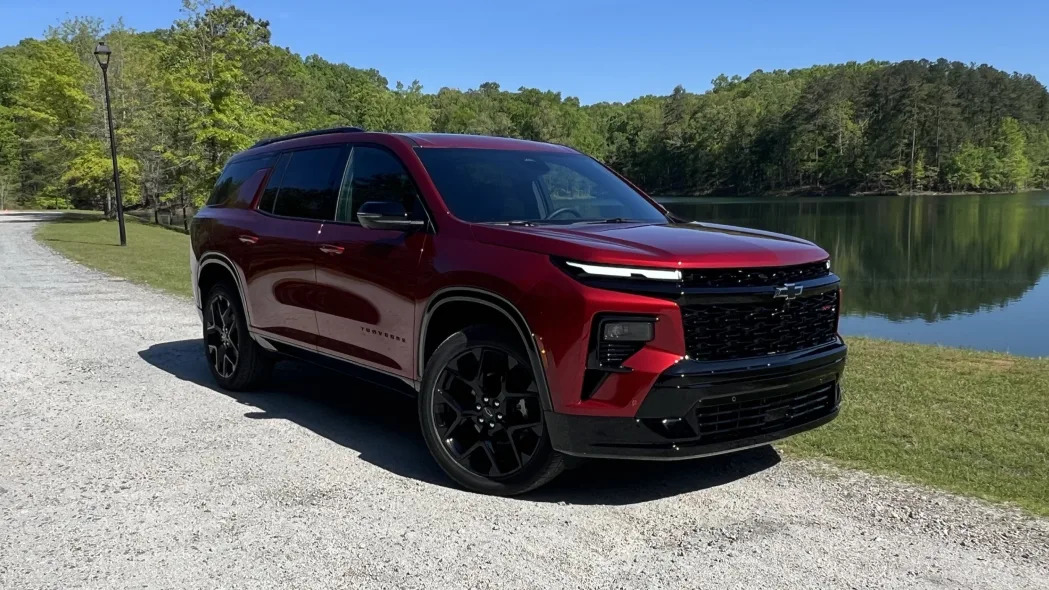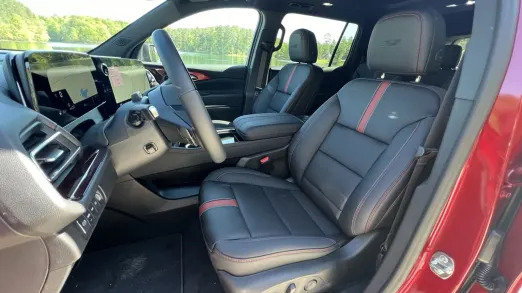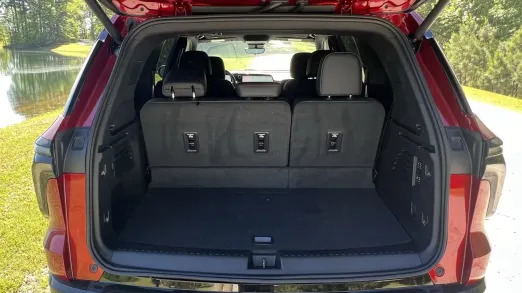DOUGLASVILLE, Ga. — The 2024 Chevrolet Traverse marks the start of the three-row crossover’s third generation. While it still serves the same general purpose as before, it does so with actual style this time. It gets new looks, which align more with the body-on-frame side of the Chevy family tree, giving this family hauler a beefier and sportier character. The interior gets a makeover, too, with dual screens on the dash providing a tech-inspired focal point. Chevy also introduces the rugged-looking Z71 and street-savvy RS trims at the top of the lineup, providing a bit of spice on top of the Traverse’s fresh flavor. It was those two trims that we got to experience on our brief drives outside of Atlanta.
The changes are beyond skin deep. Gone is the 3.6-liter V6 that made 310 horsepower and 266 pound-feet of torque, along with its nine-speed automatic transmission. It’s replaced by a new 2.5-liter turbocharged four-cylinder sending 328 hp and 326 lb-ft to either the front or all four wheels via an eight-speed automatic. The Traverse’s 2.5-liter is a new engine, but it’s based on the 2.7-liter turbo first seen in the Silverado but adapted for the Colorado. One of the goals for the 2.5 was improved fuel economy, and to achieve this, the engine employs a new-to-GM “ePhaser” to adjust the camshaft on the fly to advance and delay the spark according to power and efficiency needs (the ePhaser also allows for smoother reignitions from the stop/start system). The new Traverse gets 20 miles per gallon city, 27 mpg highway and 23 mpg combined with front-wheel drive, or 19/24/21 mpg with all-wheel drive. Compare that to the 18/27/21 with FWD and 17/25/20 with AWD from the year prior.
The list of standard safety equipment has expanded considerably, and is, frankly, impressive. New for 2024 is the buckle-to-drive feature, which locks the car out of drive for 20 seconds after ignition unless the driver buckles their seatbelt. If that makes you irrationally angry, it can be completely turned off in a settings menu. Other standard safety features that are typically optional or not available at all on competitors: a teen driver feature, haptic safety alerts through the seat, an HD surround view parking camera, traffic sign recognition, side bicycle detection (which helps keep cyclists from getting doored) and intersection automatic emergency braking. There’s more, too, and their standard inclusion positions the Traverse as a laudable embodiment of a commitment to safety.
The new Traverse Z71 trim ($47,795) brings some off-road cred to the Traverse, and it’s not just an appearance package. Its 1.2-inch increase in ground clearance (for a total of 7.76) and all-terrain tires wrapped around 18-inch wheels are the first giveaway that this is better equipped to make a capable departure from the pavement. Look a little closer, and you’ll notice the red tow hooks and skid plates, with aluminum up front and steel protecting the engine, transmission and rear differential. The Z71 also gets a twin-clutch all-wheel drive system allowing the Traverse to shift torque between the left and right rear wheels as needed. Its ZF FE4 passive dampers use specially tuned valve technology for frequency-based damping to allow for an improved balance between ride and handling. In the Z71, the dampers also include a hydraulic rebound stop to prevent that “slap, that hard clunk,” as Lead Development Engineer Van Childers described it, when you run out of rebound travel.
The Z71 adds new Off-Road and Terrain driving modes. Terrain mode is what you would use for slower, more technical, well, terrain, where you might be creeping over obstacles and traversing steep, um, terrain (the name is apt, we must admit).
“Think of it as one-pedal drive,” said Childers. “You come up to an obstacle on a two-track somewhere, and you know you can clear it given the ground clearance you have, and you literally crawl up on the thing, stop, and then kind of get the thing to drive off, and it really only moves when you’re on the gas.” Lift off the accelerator, and Terrain mode will hold you still wherever you are without the Traverse rolling away from you. With Off-road mode, Childers noted, “We actually freed up the vehicle … we backed off on our controls a bit, as far as traction control and stability control,” allowing more slip and yaw. Sometimes you want or even need more wheelspin in certain conditions, and Off-Road mode gives it to you.
The very top trim, the RS ($57,595), is the sporty, street-focused, best-equipped Traverse. As such, it gets the appropriate looks, with 22-inch gloss black wheels, and black accents on the grille, moldings and roof rails. Inside, it gets a three-spoke, flat-bottom steering wheel, RS embroidery on the headrests, and a red-accented black interior. Much like the Z71, the RS isn’t just an appearance package. It gets the same ZF shocks with passive selective damping control technology, but they’re tuned specifically for on-road comfort and handling — oh, and they don’t have the hydraulic rebound stops. Sitting at the top of the lineup, the RS comes standard with equipment that’s optional on the Z71, like Super Cruise, Bose premium audio and power everything. It also has really nice perforated leather seats.
Our first stint in the 2024 Traverse took place in the Z71 on grass and dirt trails on the expansive property of Foxhall Resort outside Atlanta. Carrying speed in Off-Road mode, gliding over undulations and dodging the odd flock of geese, our first impression (and most lasting) was that the Z71’s ride is extraordinary. The combination of all-terrain tires wrapped around 17-inch wheels and the tuning of the Z71’s suspension turned the otherwise choppy terrain into a comfortable conveyance. Transitioning from lumpy grass to rutted dirt two-tracks, we continued, keeping our pace around 40 to 45 miles per hour, and marveling at just how undisturbed the cabin remained despite the violent interactions occurring between rubber and earth.
This, we thought, would be a hoot on the sandy trails crisscrossing the tip of the mitten of Northern Michigan … and absolute dynamite on the cratered pavement that Southeast Michigan calls roads. We can’t wait to get a Traverse Z71 in our local fleet.
The route took us up into wooded hills on a trail used to access a number of the resort’s clay shooting traps. Apart from a couple narrow gaps between trees on a trail that seemed designed for UTVs, it wasn’t difficult terrain, but was a pretty good simulation of the sort of conditions you’d encounter on your way to a cabin or a campsite deep in the woods. We didn’t get the opportunity to crawl over any rocks (nor shoot skeet), but we did have the brief opportunity here and there to use Terrain mode over some bumps and inclines. It works as advertised. This venue also provided the chance to use the various cameras to help navigate over blind crests or between trees — and the camera screen doesn’t disappear as soon as you start going faster than a crawl. Take note, Toyota.
Our drive in the RS took place on actual roads outside of Atlanta, some of which were actually curvy. The Traverse handled itself well. Slicing through the corners was work, with steering that was properly weighted if a little artificial in its feel. It traced through the curves with no problems, the car feeling a bit smaller on the road than it looks from outside. The ride, again, was comfortable, despite the massive 22-inch wheels exclusive to the RS. That said, these roads were much smoother than those closer to Chevy’s hometown of Detroit, so we’ll have to get a longer test back home to give a final verdict on the RS’ level of comfort. This initial drive bodes well, though, and proved the suspension is properly suited to roads with plenty of undulations. How it deals with massive potholes is TBD. Either way, there’s always the Z71 if your infrastructure is as shoddy as Michigan’s.
The new 2.5-liter engine is a worthy fit for the Traverse. Like a good four-cylinder should when paired with a massive SUV like this, it keeps quiet and out of its own way. It delivers power quickly, just as the engineers promised it would, thanks to the short pathway between the intake and the twin-scroll turbocharger. While it doesn’t offer quite the flat power curve of the previous generation’s V6, there is more power on tap, and it arises in a linear and predictable fashion. Our RS tester was an all-wheel drive version, but like other GM crossovers, you have to press a button to engage the system’s ability to send power to the rear wheels when front-wheel slippage is detected. With the AWD button poked off and the drive mode set to Sport, we could get the Traverse to spin its front wheels from a stop with a stomp of the accelerator.
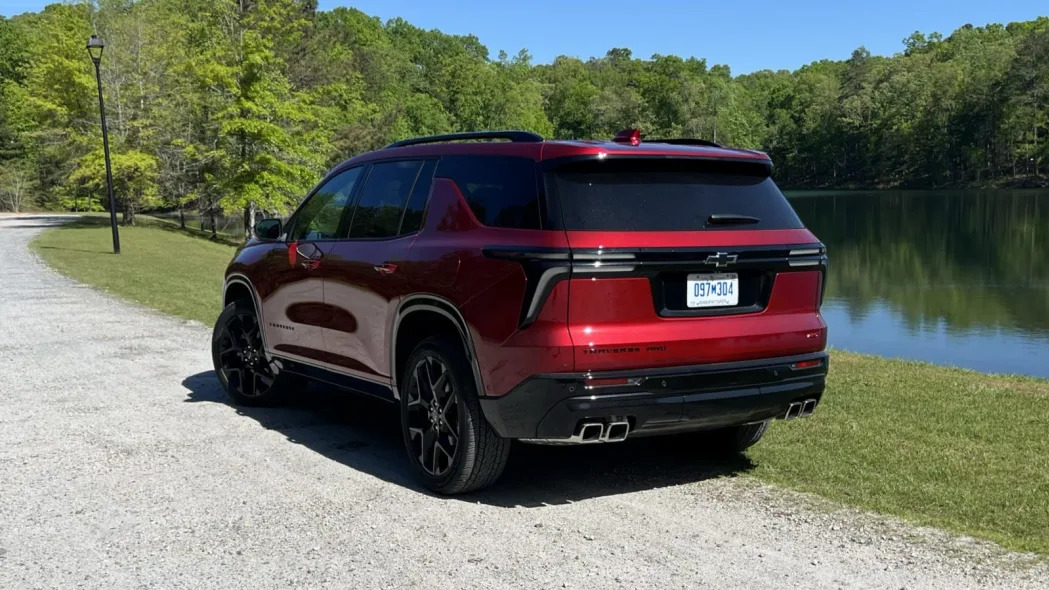
Adaptive cruise control comes standard across the Traverse lineup, but GM’s Super Cruise hands-free driving technology is available in the LT and Z71, and standard on the RS. And, man, Super Cruise just keeps getting better. We were able to activate it on a number of two-lane highways off the beaten path; places we were surprised it would be available (and GM is looking to expand its network to cover 750,000 miles across the U.S. and Canada by the end of next year). Super Cruise remains a trustworthy companion, capable of taking over some driving duties without scaring the crap out of you and, importantly, being clear but not annoying in the instances it needs you to resume full control.
The interior of every Traverse features the same Android-powered infotainment system that has already impressed in other Chevrolets with its menu structure and customization options, including which apps are docked at the top. And while you can adjust climate control through the screen, the new Traverse retains its physical HVAC controls further down the center stack. And yes, there’s still a real volume knob, too.
As always, the Traverse is enormous. Interestingly, though, second-row captain’s chairs and therefore seating for seven is standard on all but the eight-seat, second-row-bench-equipped LS trim ($40,995). Like other three-row SUVs, the second row slides to increase space for those unlucky enough to find themselves in the third row. They won’t be that unlucky in the Traverse, though. At 6-feet tall, I was able to find a position where I could sit comfortably in the third row, behind a hypothetical clone of myself in a comfortable second-row position, behind another clone (can you imagine?) in my ideal driver’s seat position. Cargo space is tremendous. There’s a full 22.9 cubic feet behind the third row, which may be down on the old version’s 23.6, but still bests everything in the segment. Put the third row down, and you get 56.6 cubes, with a maximum 97.6 cubic feet behind the first row. If you need more stuff, you can pull it behind you — the Traverse is rated to tow 5,000 pounds.
While we’ve got a lot more to explore when it comes to the 2024 Chevy Traverse, what we’ve experienced so far is impressive. It drives well, it’s roomy, the tech is good, it’s far more stylish than before and its new trim levels cater to a greater variety of tastes. It’s much more worthy of your consideration than before, even in a world where crossovers like the Hyundai Palisade and Kia Telluride exist. We’re excited to get more time behind the wheel with a full load of passengers and cargo – especially in that Z71.


